
A Potter and Helper Create a Vase
In mid-July four senior couples serving in Ghana set out for a few days of sight seeing. Their destination was Mole National Park in the Northern Region of Ghana. They had heard from other missionaries and church employees that the park had elephants, monkeys and other wild animals. They traveled in the Area VW van with a hired driver.
Since Mole is about 400 miles north over crowded, narrow and sometimes rough roads, they stopped in Kumasi to spend their first night. Kumasi is the capital of the Ashanti Region in central Ghana and about a five-hour drive from Accra. The second largest city in Ghana (Accra is first), it is a commercial and transportation center in a cocoa-producing region and also the home of the powerful Ashanti Tribe.
While in Kumasi they visited the Kumasi National Cultural Centre and watched as artisans worked on their various crafts. Many of the crafts were for sale so they did some shopping too.
Here a potter demonstrates how he creates a vase on his potter’s wheel, which is being driven by a second man turning a handle. For the potter’s creation to become a work of art, the man at the crank must turn the handle at a consistently steady rate.

A Potter and Helper Create a Vase
This woman is drawing a pattern on her fabric to be colored by the batik process. To create batik fabric, material is given a base color, then hot wax is applied in a pattern and the cloth is dyed again with a different color. This time the wax shields the fibers in the pattern from the dye. After the dye is dry, the cloth is boiled to remove the wax. The results are beautiful.
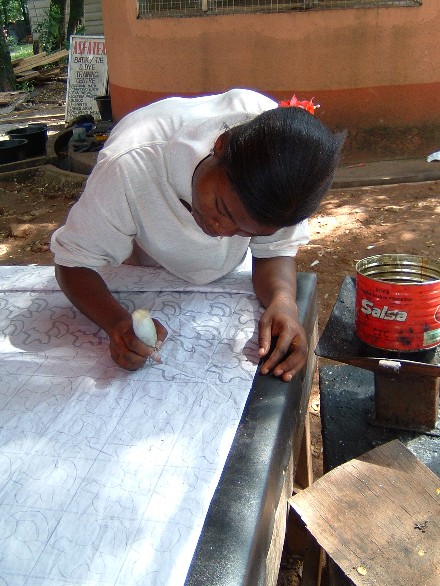
A Batik Design Being Drawn
Here a salesgirl stands in front of some of the beautiful batik fabrics that are for sale. They sell for 25,000 cedis per yard, which is a little less than $3.
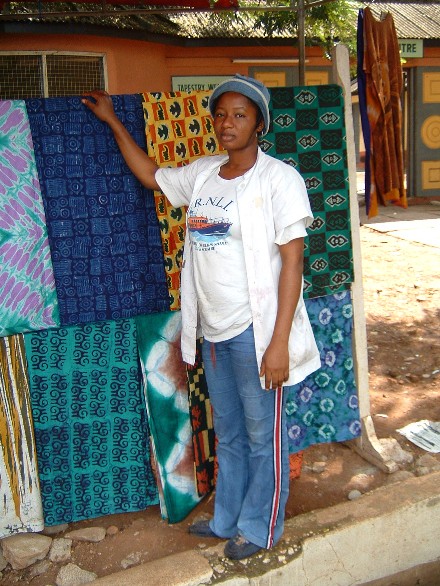
Batik Fabric For Sale
Batik wall hangings are also a popular item in Ghana. Here a man is drawing the outline of the figures that will be on his batik. This is unique art.
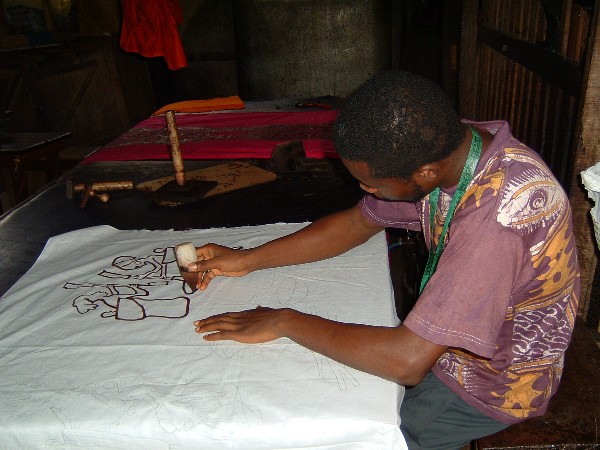
Batik Wall Hanging Artist at Work
Colorful batik wall hangings are for sale.

Batik Art For Sale
Here a drum maker sits hollowing out his drum. A certain wood is used for drums, but we don’t know the name. The logs are cut into pieces of proper length and the bark is stripped off. The wood is allowed to dry before being hollowed and carved for the drum body.
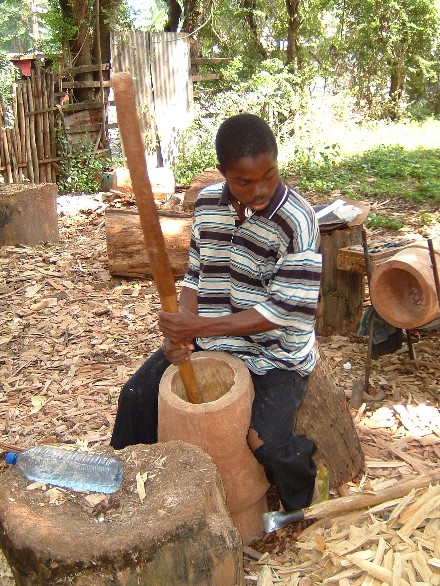
Hollowing the Drum Body
Another artisan makes beautiful carvings on the outside of the drum. Use of drums is very common for almost any gathering of people including: church meetings, weddings, funerals, birthdays, opening of new stores or businesses, school events and parties.

Decorating the Drum Body
This man is making bamboo furniture to sell. He made sure we understood the furniture was bamboo and not wicker. Bamboo is much stronger, harder to work, and therefore more expensive.

Producing Bamboo Furniture
The next day we left Kumasi for Mole. On the way we passed many quaint little thatched-roof villages such as this. They remind us of something from a children’s storybook. They are very beautiful.

Village in Northern Region of Ghana
Just outside the entrance of Mole is a little town by the name of Larabanga. This Muslim mosque at Larabanga is one of the oldest mosques in West Africa. Though no one is absolutely sure, the locals are fixated on the year 1421. The mosque is still used for worship and is also a popular tourist attraction. On the afternoon we were there the locals crowded around us and made us feel welcome. A designated tour guide gave us a brief history of the mosque and then we spent a short time mingling and visiting with some of the villagers. The children were especially interested in spending time with us. One little boy asked me if I could give him any pens for writing. All I had with me was a Sharpie permanent marker, so I gave it to him, explaining that it was a very special pen that was only to be used on paper. I had nightmarish visions of permanent marker graffiti all over the beautiful, whitewashed mosque!

A Mosque First Built in 1421
We entered Mole National Park and shortly thereafter arrived at the Mole Motel, where we were greeted by baboons who seemed to be perfectly comfortable in the motel compound. One group of young people staying at the motel failed to lock their door and a big baboon entered their room and made himself at home. This particular baboon checked the contents of the motel trash can several times a day to see if anyone had thrown away anything tasty.

A Friendly Baboon
This is the breathtaking panoramic view from the back of the motel. If we looked carefully, we could see elephants bathing in the ponds below. We could also see antelope/deer and baboons.

View from Hotel
Later that afternoon we set out with our guide on a two-hour walk through the beautiful savannah. Just outside camp we encountered this big old fellow (or gal) having a drink of water from a large cement drum. He seemed oblivious to our presence.
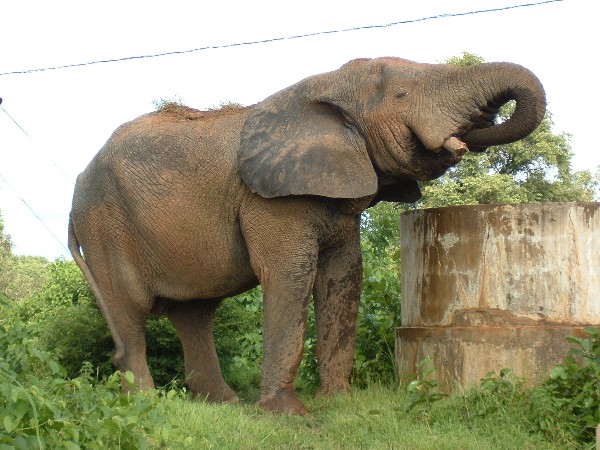
Elephant Drinking from the Hotel Water Tank
Here a little family of olive baboons is resting on a rock. We decided this game reserve was a great place for them and the other small and large mammals that inhabit it. Some of the species living here are elephants, crocodiles, buffalo, hippo, warthog, several species of antelope/deer, and several varieties of primates and reptiles. There are also occasional leopard and lion sightings.

A Family of Baboons
Here our guide, Biney James, is giving us instruction on the plant and animal life in the forest. Each of the guides carries a gun, though Biney (we called him James) told us that he had never had to use it.

Biney James with Rifle
James spotted three elephants and as we tracked them through the forest, we felt like big game hunters. Each time we encountered them, we were able to get as close as 20 meters away. We almost had to pinch ourselves to make sure that we were really standing there looking at elephants who were standing there looking at us. A couple of times the elephants made sudden movements as if they were going to run toward us, and then the ladies screamed and scampered away. James told us not to run. “They won’t come,” he said on more than one occasion. Sister Armstrong wasn’t totally convinced of that, however.

Elephant in the Forest
This picture was taken as we walked through the beautiful, low savanna where these magnificent animals live. We saw warthogs, elephants, several types of deer and antelope, baboons and other kinds of primates. We never saw a snake, however, for which we were grateful. We wondered if Biney James would know what to do if any of us were bitten by a green or black mamba.

The Savanna
Dan is standing in front of an interesting tree in Mole Park. The center is hollow. It appears that there was an old tree around which many smaller ‘vines’ grew. The original tree died and was eventually eaten away by insects and decay. But the numerous vines had become self-supporting so they remain as ‘the tree’. Is there a parable in this story?

The Hollow Tree
On our second day in the park we rode in our trusty Volkswagen van down a pretty rough road to where the elephants were splashing and playing in their watering hole, the one that we could see from the back of the motel. We imagined that this must have been very pleasant for them to enjoy the weightless buoyancy in the water while cooling off at the same time.
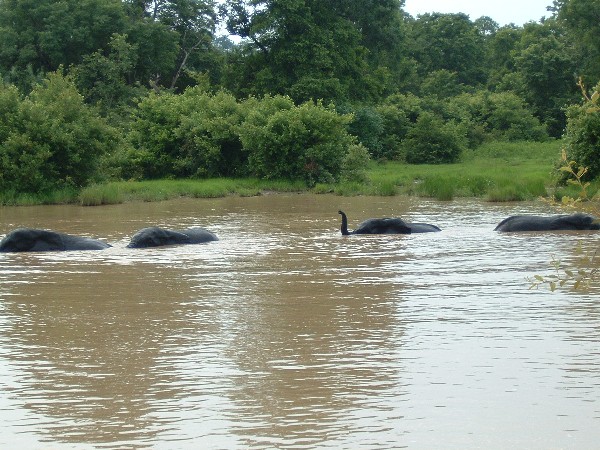
Elephants in the Pool
Here several of the elephants have gathered together on the banks of the watering hole. Our guide pointed out to us a yawning crocodile not too far from where they were standing.
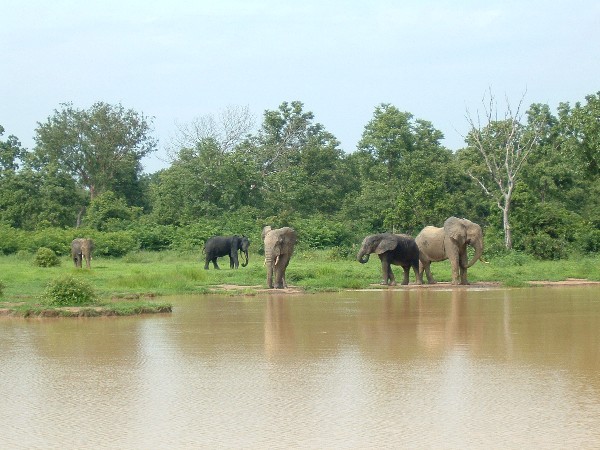
Elephants on the Bank
Elder Huff, a senior missionary proselyting with his wife in Dodowa, a village about 20 miles north of Accra, gave Biney James a Book of Mormon and talked to him about its significance. Here James is proudly carrying his Book of Mormon. Way to go, Elder Huff!

Biney James with His Book of Mormon
As we started our journey back to Kumasi, where we would again spend the night, we noticed that there were no petrol stations to speak of. Since we were very low on gas, we had to stop at this gas “pump” to put in just enough petrol to get us to a real gas station.

Petrol (actually diesel) Stop
Children gathered around us wherever we went. Maybe it’s because we looked like their grandparents, or maybe it was just because all of those old white people together were a sight to behold. This group of happy, giggling children posed for us at the petrol station.

Children at the Petrol Stop
These ladies were walking across the street from the petrol station. Would you have the big smiles they have if you were carrying such a heavy load on your head? African women work hard. They are our heroines.

The Local Women with Fuel
There was a police barricade next to where we bought gas. Sister Huff, who is very friendly and likes to get to know the African people better, struck up a conversation with them. After she had her picture taken with them, Sister Armstrong decided to do the same. They seemed very happy to have their photo snapped with us old obruni women.

Local Police Pose with Sister Armstrong
A short while later we drove down another rough dirt road to the Buabeng-Fiema Monkey Sanctuary. This sanctuary is in a village where people live and work. There are two species of monkeys who live in the village and the woods surrounding it: mona monkeys and black and white colobus monkeys. The monkeys, which are considered sacred by members of the village, are pampered and protected. We saw one chasing a screaming toddler, and the father gave the young boy a scolding for getting in the monkey’s way. Here a mona monkey, which is the most outgoing of the two species, is giving our van a good inspection.

Monkey Inspects the Van
We walked into the woods with our guide to this little graveyard where some of the monkeys were buried alongside two of the village’s religious leaders. They trees were teeming with monkeys overhead.

Monkey Graves
Click here to return to the Armstrong menu page